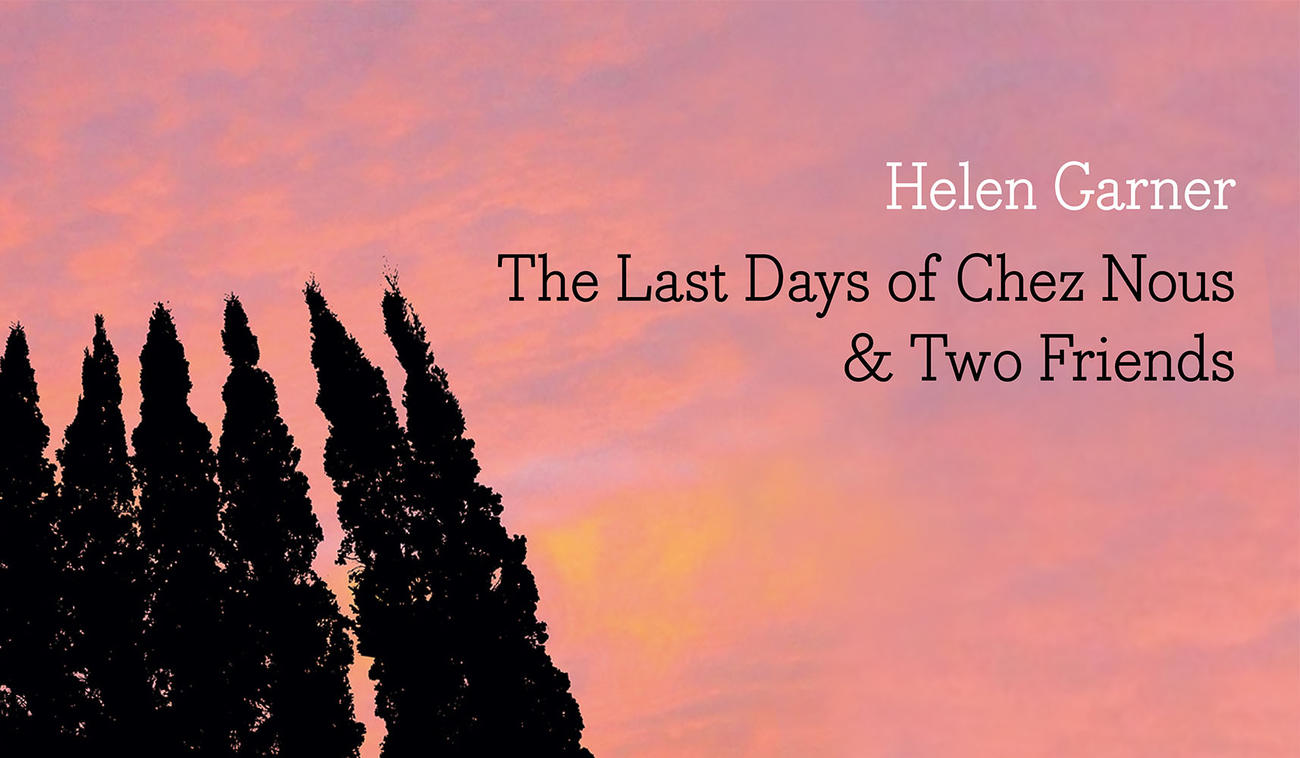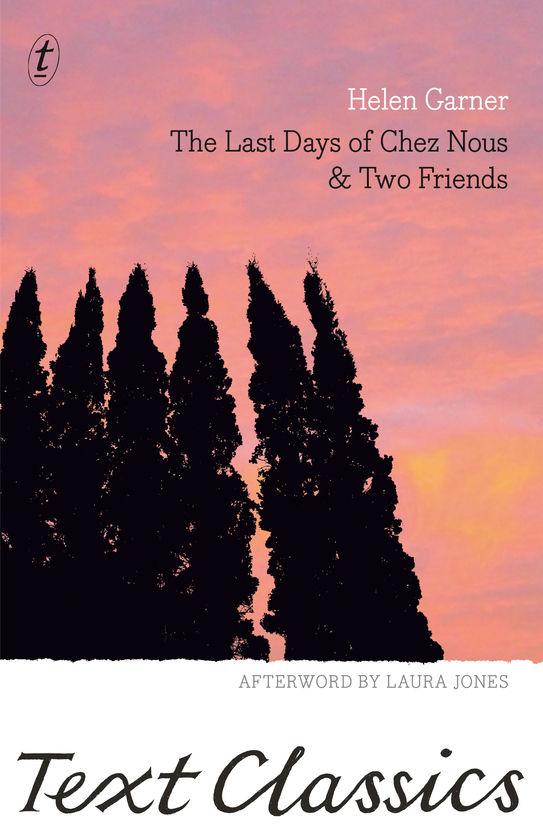
Our newest Text Classic is two screenplays by Helen Garner: The Last Days of Chez Nous & Two Friends. In her afterword, screenwriter Laura Jones, whose credits include adaptations of literay gems Brick Lane, Possession, Oscar and Lucinda, A Thousand Acres and An Angel at My Table, describes the screenplays as having ‘a tighter focus than Garner’s other fictions. They have a different purpose: they are written for performance and visual storytelling. They are to be seen differently, absorbed differently. But, like the novels, they are a joy to read.’
In the extract below, Garner describes, as only she can, the thrill of jumping into the ‘bunfight of screenwriting’ and discovering a new way of telling stories.
You can write a whole novel with your left arm curved round the page. You can get to the end of the last draft without having shown it to a single person or made one compromise. Even if you have to battle with an editor, the book reaches the reader pretty much as you intended it. All its mistakes and failures are yours, totally and forever, and so are its little glories. When the chips are down, you are the book, and the book is you.
Why would a novelist turn her back on this marvellous freedom, this privacy and independence, and sneak into the bunfight of screenwriting?
I did it for the money. That was my first reason, anyway. At a friend’s wedding I met a producer I liked who asked me to contact her if I ever felt like writing a movie. Naïvely, and being broke at the time, I rushed home and rummaged in my folder of unexamined ideas. Out of it stepped Kelly and Louise, the young girls who became Two Friends.
But within a week I realised that though the money is a spur, it’s also only a mirage, once you’ve sat down at the desk. I found that film writing is powered by the same drives as fiction. You do it out of curiosity, and technical fascination, and the same old need to shape life’s mess into a seizable story.

I’ve seen a lot of movies, but I hadn’t a clue how to write a screenplay. The formal stages of its development—outline, treatment, drafts—were utterly foreign to me. When I write a novel or a story, I never plan. I circle round the dark area of life (mine, or someone else’s) to which my curiosity is attracted, and I search for a way in. My method of work is a kind of blind scrub-bashing, a blundering through a trackless forest.
But now I found I was required to sit up brightly in a watchtower and tap out a preliminary map of the territory. I had to turn my old, organic, secretive, privileged, hypersensitive work process inside out.
This was the hardest part of the change, for me. I’m used to working alone. It suits my nature. I can’t stand it if anyone (no matter how dear) comes into the room behind me while I’m working. I have to cover the pathetic, scrambled mess on the page. I like to get the thing as perfect as I can make it, before I hand it over.
With movies, this won’t wash. I had to learn to walk into someone else’s room, whack down my idea like a lump of raw meat, and watch it quiver while it was rolled and prodded on the table.
This might easily have been as gruesome as it sounds; but in fact my brief experience of filmwriting has been an intense pleasure, because of the calibre of the people who introduced me to it: Jan Chapman, who produced both these films, and the directors Jane Campion (Two Friends) and Gillian Armstrong (The Last Days of Chez Nous). Long script sessions with these three classy, generous and challenging professionals taught me to drop my defensiveness and become more flexible at an earlier stage, before my thoughts could set themselves in concrete. They showed me the priceless art of the apparently dumb question, and the calm brazenness that is required in order to ask it. From Gillian Armstrong I learnt that before you can cut something out of the story you have to understand fully what it is, instead of dropping it because you’re too lazy to think it right through. I learnt (from Jane Campion in particular) to follow and trust intuition, no matter how alarmingly it swerves. And most valuably of all, because it applies to everything written in any genre, all three of them forced me to learn and relearn the stern law of structure.
What I had seen, in a late draft of Chez Nous for example, as a perfectly smooth narrative curve would turn out, under their skilful probing, to be more like a little Himalaya of mini-climaxes. Special effects a novelist might pull off on the page by bluff or flashy language simply will not transpose to film. Everything has to be reinvented through the eyes. It was very squashing to have to leave my precious prose at the door and be pushed back again and again to the bare bones of structure and dialogue. There is nothing else, it seemed at times. So hard, to be so stripped!
But there’s a payoff: how shockingly easy it is just to write ‘Night, a desert motel’, or ‘She takes her father’s arm’, and to leave the rest, the complex labour of providing the detail that will fill the bare places and acts with meaning, to the director’s incredibly numerous and expensive army of actors and technicians. The ease of it—it seemed criminal; I felt almost guilty.
Does anyone understand the alchemy of many imaginations that distils a film? An actor’s mistaken emphasis can throw a carefully crafted piece of psychology out of whack. The wrong brand of teacup on a table can skew a family’s fantasy of itself. But by the same token, the tiny upward movement of one facial muscle, spontaneous, unconscious, impossible to write, can transform the emotional mood of an entire sequence. A director can take hold of your stick of an idea and make it blossom into a poetry your plodding typewriter could never have dreamt of.

I’ve read the horror stories and I know how lucky I’ve been. At the start I was hampered by a pathetic gratitude that my work was even considered filmable. I didn’t (and still don’t) understand the writer’s position and power in the hierarchy of the production army. I was often too proud to ask the dumb question that would have taught me what I needed to know. I discovered in myself a passivity I never knew was there. I stayed away while the films were being shot, and when you’re not present, when you’re in another town, everything you think is always too late. I accepted without a struggle, over the phone, last-minute changes the necessity of which I was too inexperienced to judge. I still haven’t learnt how—and when—to fight for what I see as crucial. I haven’t yet learnt to foresee the flashpoints where imagination and budget might collide, and to take a stand long before the moment, on location, when the crucial is found to be impossible and the lesser road must be taken.
In Chez Nous, for example, there are the cypress trees.
From the main characters’ bedroom window I wanted a row of pencil cypress trees to be visible, growing in a distant and unidentifiable neighbourhood garden. These trees, to me, carry a heavy freight of meaning. They are Mediterranean, and connected with the origins of our culture. They are calm, sturdy, graceful. They are a reminder of darkness, of stillness, of death—and thus of the question of God, and the soul. At certain charged moments in the plot of Chez Nous, people glance out the window and see the cypresses. Once, Beth speaks of them to her pregnant friend in a way that tells us a good deal about her.
In this book you will read about the cypresses. But in the film of Chez Nous you will not see them.
When a terrace house in Glebe was chosen for the film, it was perfect in every way except one: there were no cypress trees. The cypress trees, it seemed, would not be possible. I went to the house with Jan Chapman and Gillian Armstrong, and we walked from window to window, looking for something to replace them. Then, from an upstairs room we saw, beyond the thick summer foliage into which the house backed, the tip of a church spire, just floating there. The building to which it was attached was completely hidden by leafy branches. At that anxious moment it seemed a gift, and we persuaded ourselves that the spire would do.
And in a sense it did do—but a resonance departed. A spire, no matter how indistinct and beautiful, is literal. It represents a known religion, a particular theology, with all the sectarian and social meanings that this entails. The mystery of the image is lost. So in this book I have taken the liberty of removing the spire, and putting the cypress trees back in.
The qualities of air and light in a certain place, I now realise, are more than simply aesthetic. They form the tone of people’s lives, the way people move about and behave towards each other and feel about themselves. Both these films were imagined in Melbourne and shot in Sydney. I didn’t think this would matter, but the experience has taught me that the two big cities of Australia are tonally as distinct from each other as Boston is from LA, or Lyon from Marseilles. The very image of a house, on which both films heavily depend, bears one sort of psychological emphasis in warm, open Sydney, and a completely different one in Melbourne, where dwellings are enclosing, curtained, cold-weather-resisting: more like burrows.
These are only a few of the lessons I have learnt. I don’t know yet whether I will have another chance at applying them to a film. I think I will always prefer to write fiction. Collaboration, if you’re used to the long spells of obsessive loneliness that fiction demands, is weirdly over-exciting. You go home each day suspecting that you have made a complete fool of yourself. It feels illicit. All that laughter!
Can this really be work? People hang around whose job is to bring you a cup of tea! A sandwich on a plate! And to clear away the crockery afterwards while you go on talking! You are afraid of being swallowed up by the seductive machinery of it, the intricate balancing of forces that you barely understand.
And as for the money—the appalling sums it costs, to make your ideas visible—I will never get used to this. Thinking about it nearly makes me keel over. Yes, at the beginning I really thought I was doing it for the money. But now I know that if I do it again, it will be for the slightly crazed pleasure of collaboration, and for the subtle little quiver of possibility that the enterprise gives off at the start—the distant flicker of a not yet perfected story that might end up satisfying and deep, if the chemistry is right. And, of course, for the moment when you sit down in the dark and see your characters walk and talk, with tones in their voices and expressions on their faces; when you see them spin away from you and out into the world of strangers.
Helen Garner
Melbourne, 1992



